
Dock of the Bay

Volume VII Number 15
April 15-21,1999
Safeway Polls Anne Arundel
'NIMBY' Strength
photo by Mark Burns
If Safeway's consideration of the Southern Anne Arundel community of Deale were a courtship, you'd classify it under the Captain John Smith variety. In its latest move, the nationwide supermarket chain has sent an intermediary to measure its intended's interest.
Calls were received through the first weeks in April from a polling company that identified itself as Golden Research out of Minnesota, community sources told New Bay Times.
The poll, they reported, was a short one, seeking yes or no answers to three questions:
1. Are your shopping needs being met?
2. Are you averse to a Safeway or Food Lion in your community?
3. Would you support such a supermarket with no fast-food site?
Two supermarkets were named in the poll, according to some reports. Others
said they were questioned about Safeway alone.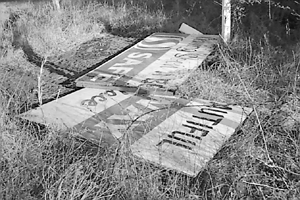
"We are indeed conducting some market research in the Deale area," Greg Ten Eyck, spokesman for Safeway's Eastern Division, confirmed.
"We know from demographics and the need for a store in this area that if we are able to build, we will be very successful," Ten Eyck said. "But sometimes we still want to quantify attitudes," he noted.
Ten Eyck would not discuss the scope of what he called an "internal evaluation." He did, however, express corporate confidence in the community's willingness.
"Typically when we're ready to open a store no matter where," Ten Eyck said, "some people express displeasure. We generally find the vast majority of people excited and supportive, but unfortunately we usually hear only from the NIMBYs."
NIMBY is a acronym abbreviated from 'Not In My Back Yard.' It's applied, often derisively, to people or communities who might not oppose, might even support, a project in principle - as long as it didn't drop down in their back yard.
"That's the wrong term," said Ron Wolfe, chairman of the newly appointed Deale-Shady Side Small Area Planning Committee. "NIMBY applies to something you believe belongs somewhere else. We don't think a supermarket should be built in Shady Side, Friendship or period in Southern Anne Arundel County. We don't want a store that will destroy the environment in our Bay or our wetlands."
Added Wolfe: "The fact that over 2,000 people have freely signed petitions against the Safeway is a pretty eloquent statement about how this community feels."
-SOM
Boats Unwrapped, Wrap Recycled
photo by Mark Burns
This time of year, all that stands between many boats and the Bay is three or four hundred feet of shrink wrap.
Removing the plastic is becoming a standard part of dewinterizing vessels for boat owners throughout Chesapeake County.
"More people each year see benefits of shrink-wrapping their boats," said Mike Myers, whose business includes wrapping boats over-wintering at Herrington Harbour North. "When you have a bad winter, the next year more people want to have shrink wrap. These expensive boats sit out in the open four or five months, and it's hard on them."
In past springs, when boat owners or Myers pulled off the shrink wrap, it went into the trash.
"In the past, it simply went into the waste cycle. Nobody wanted to jump on the bandwagon or initiate the effort to recycle it," said Myers.
All that waste was more than John Polek could stomach.
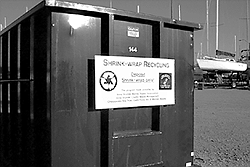 Two
years ago Polek, of Sunset Harbor Marina in Baltimore, had a saving idea.
Plastic is a popular recyclable; shrink wrap could find new life in another
form. Baltimore and Kent counties established volunteer sites to collect
used boat shrink wrap. Full receptacles were hauled to the Giant Food Recycling
Center in Jessup. Manner Resin of Annapolis completed the recycling process
by locating buyers for the tons of polyethylene.
Two
years ago Polek, of Sunset Harbor Marina in Baltimore, had a saving idea.
Plastic is a popular recyclable; shrink wrap could find new life in another
form. Baltimore and Kent counties established volunteer sites to collect
used boat shrink wrap. Full receptacles were hauled to the Giant Food Recycling
Center in Jessup. Manner Resin of Annapolis completed the recycling process
by locating buyers for the tons of polyethylene.
Boating shrink wrap is reprocessed into garbage bags, plastic lumber and etching materials.
Now Anne Arundel County is jumping on the bandwagon. "It's a major step for us in doing something for the environment," Polek said.
Our big boating county - over 33,000 boats are registered in here - weighed the benefits of the program and decided to begin a new era in recycling this boating season.
"I think it is a question of getting to the right person and making them realize the magnitude of the problem. We did that," added Beth Kahr of the Marine Trades Association of Maryland.
Three drop-off sites are located in the county. They are Herrington Harbour North in the south, Port Annapolis in the center and Pasadena Boatel and Beach Club in the north.
"I've called the local marinas, Tri-State, Gates and Harbor Cove, and they bring their shrink wrap to us," said Tom Wilhelm, manager of the Herrington Harbour Marinas. "Already, boat owners and contractors are putting it outside smaller dumpsters as they remove it and we're moving it to the shrink wrap dumpster. We call the county to empty it when it's filled."
Said Kahr: "It's saving a huge amount of area in the landfills."
-Mary Catherine Ball
Our English Cousins: Calvert
Seekers Cross Over
photo courtesy of Kiplin Hall
Kiplin Hall, built by George Calvert,
first Lord Baltimore, in 1623 in North Yorkshire, England.
New Bay Times didn't mean to become the journal of the founding family of Maryland. But since our visit to the early days of Maryland three weeks ago, the Calverts keep turning up. "A very interesting bunch," contributor Aloysia Hamalainen called them in a letter last week. Now, the Calvert trail leads to England, where late summer brings an opportunity to learn more about this "intriguing bit of Maryland history."
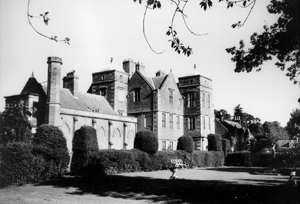 That latest is the
judgment of Professor David Fogle, who is seeking companions on his journey
to a remote part of England to discover "the birthplace of Maryland."
Fogle, who is director of the University of Maryland Graduate Program in
Historic Preservation, tells an alluring tale.
That latest is the
judgment of Professor David Fogle, who is seeking companions on his journey
to a remote part of England to discover "the birthplace of Maryland."
Fogle, who is director of the University of Maryland Graduate Program in
Historic Preservation, tells an alluring tale.
The birthplace of Maryland, he writes, is a stately Jacobean mansion overlooking the beautiful Yorkshire dales. Built in 1623 by George Calvert, first Lord Baltimore, Kiplin Hall was to be the ancestral seat of five generations of the founders and Lords Proprietor of Maryland.
Calvert rose from a modest beginning to become secretary of state to King James I. A Roman Catholic who had to resign his position when Catholicism was outlawed in England, he founded Maryland as a refuge for English Catholics. His son Cecil, later the second Lord Baltimore, was given the estate, called Kiplin, at the time of his marriage to Anne Arundel.
The estate passed on by marriage to three other families, but by the mid-20th century it had fallen into disuse. Various plans would have turned the property over to Maryland, including a 1940s' scheme to dismantle the mansion and reconstruct it in Annapolis as a residence for the governor.
None succeeded.
In the 1970s, the estate was willed by its last private owner to a charitable trust. Kiplin Hall is currently undergoing major restoration, as recipient of a major grant from the English heritage lottery fund.
Still, a bridge to Maryland was built. Since 1990, the University of Maryland has leased a portion of Kiplin Hall as a summer study center. Maryland students earn credits, study English history, literature and architecture and occasionally do hands-on restoration work.
To support these programs, the University of Maryland Graduate Program in Historic Preservation and the Maryland Historical Society sponsor annual Lord Baltimore Tours.
This year's Lord Baltimore Tour will fly to Edinburgh on August 23, writes Fogle, to experience the famous Edinburgh festival and Tattoo at Edinburgh Castle. We visit nearby Balmuto castle, ancestral home of the Boswell clan, now owned by Baltimore descendants who will receive us for dinner.
Moving north to Aberdeen and Inverness, we stop in Anstruther to visit a picturesque fisherman's museum under the direction of former Marylander Margaret Brown. Continuing the tour's tradition of meeting owners of historic properties with interests similar to Kiplin Hall, we meet representatives of the Munroe clan at their Castle Foulis.
Crossing from the east to west coast of Scotland, the tour visits Glasgow and the works of Scottish architect Charles Rennie Mackintosh. Entering the Pennine region, we visit Appleby Castle, the domain of the 'great lady of the North,' 17th century Lady Anne Clifford, who restored dozens of castles and churches in her native Westmoreland in defiance of two noble husbands and the king himself.
We go next into the Yorkshire dales to Kiplin Hall, where we have a tour and reception in the Hall with the Kiplin Trustees. Lodging is in former country houses; near Kiplin, we stay at the great regency mansion Crathorne Hall, until recently home of Lord and Lady Crathorne, who have Maryland connections.
The tour ends in London, with an option of staying on after the September 7 return. Our London hotel, the Russell, occupies the site of Baltimore House, built in the mid-18th century by Frederick, Sixth Lord Baltimore.
Now that's a trail we'd like to follow.
Professor Fogle is also director of the Kiplin Hall Study Centre and vice president of the Maryland Foundation for Kiplin Hall. Learn more from the professor at the University of Maryland School of Architecture: 301/405-6309.
-NBT
For the Trees, Johnny Appleseed
Visits London Town
photos by Mary Catherine Ball photos by Mary Catherine
Ball A.A. County Executive Janet Owens,
above, helps plant the Johnny Appleseed tree at London Town Park.
After a century and a half of absence from America's
roads and byways, Johnny Appleseed came planting at London Town Park this
week. The legendary treeplanter was greeted as an American folk hero by
tree lovers; politicians - including state lawmakers just out of session;
and school children on temporary reprieve from classes.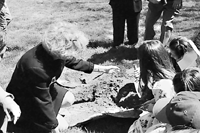
"Any one of you could be the tree planter of the next millennium," Appleseed told his welcoming committee. Among them: State Sen. John Astle, Del. Dick D'Amato, Anne Arundel County Executive Janet Owens, County Councilwoman Barbara Samorajczyk, Homestead Gardens president Don Riddle, London Town Park director Greg Stiverson and students from Edgewater, Davidsonville and North Glen Burnie Elementary Schools.
"We are very pleased to have you here to help in bringing London Town back to life," replied Greg Stiverson, speaking of the 17th century heritage site. London Town's gardens are in early bloom, but except for the Wm. Brown Public House, the village is a recovered memory awaiting reconstruction.
Maryland Sen. John Astle (from back left),
Del. Dick D'Amato, Don Riddle of Homestead Gardens, County Councilman Barbara
Samorajczyk, American Forests executive director Deborah Gangloff and Jeff
Meyers of American Forests help show off posters by school kids of the Johnny
Appleseed tree.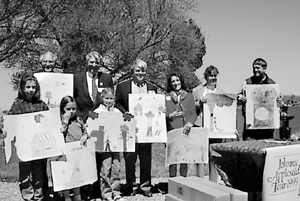
On those grounds, the wind tossed early blossoms as Appleseed joined Owens, Riddle and 18 students in planting three apple trees, descendants of the last surviving Johnny Appleseed tree, discovered in Ohio. These trees and others for each school were donated by Riddle and Homestead Gardens.
Appleseed's first career began in 1797, when he left his Massachusetts home to bring apples to the new settlers of America. Some say Appleseed, then known as John Chapman, was inspired by a vision of a heavenly apple orchard. Other give him more practical credit: in those days, a homestead couldn't be staked unless an apple tree had been planted. Whatever his motivation, Appleseed spent 48 years on the road, carrying apple trees to settlers as far west as Indiana. He walked from Massachusetts to Pennsylvania and then to Ohio, where his life's work was concentrated, before his death in 1845 at Fort Wayne.
The London Town planting celebrated Appleseed's return to his earlier ways. Supported by American Forests, the country's oldest non-profit conservation organization, Appleseed makes a 19-city tour this month, inviting Americans to plant Appleseed seedings at homes, parks and schools across the country. American Forests' Global ReLeaf 2000 campaign aims to plant 20 million trees for the new millennium.
New Bay Times will celebrate its sixth anniversary with a party and benefit auction to help American Forests meet its goal of planting one million trees in the Chesapeake watershed over the next year. For each dollar raised, one tree will be planted.
"We try to help people appreciate all the values and benefits of trees," said Deborah Gangloff, American Forest's executive director. "With these apple trees, we can plant a tree that lived before us and will live long after us."
Edgewater is the sixth stop on the modern-day Appleseed tour. From the Johnny Appleseed Visitors Center in Lancaster, Massachusetts, it traveled to New York and Washington, D.C. The tour will continue with stops in Pennsylvania, Ohio, Michigan, Illinois, Iowa, Indiana and Tennessee, before concluding in Virginia Beach.
Aiding the always indefatigable Appleseed in this 19th century tour is Jeff Meyers, director of American Forests' Famous & Historic Trees project.
-MCB with NBT
Toward a Cleaner Bay: Maryland's Manure Marketplace
Manure mongers from all over Maryland now have a safe and potentially profitable market for their pungent assets.
The Maryland Department of Agriculture unveiled the new Manure Matching Service last February, followed soon after by the Poultry Litter Transport Project. Together, these two programs are expected to help save the Chesapeake Bay by sending manure to market rather than into the tidewater.
"We're trying to promote better utilization of animal waste," says Norman Astle, coordinator for the Poultry Litter Transfer Project and spokesman for the Manure Matching Service. "Therefore we should see positive effects for the environment, particularly as it relates to phosphorous."
The free matchmaking service couples suppliers - farmers burdened with pungent piles of excess manure - and the have-nots, people who need the fertile matter for crops or alternative-use business ventures. As a conduit between the two, the service hopes to reduce animal waste runoff by getting the manure to people who can make use of it.
Though young, the Manure Matching Service has already welcomed several farmers into the fold. "Right now we have around 40 entries, all pretty much receivers, not much in the way of sending farms," says Astle.
Astle isn't worried about the imbalance of supply and demand. It's too young a program, he insists, to have built up strong interest yet; though the matching service has tasted success. "Last week we did a match," notes Astle. "One sending farm was matched with 10 receiving farms' criteria, and that litter is pretty much spoken for."
To get their slice of the cowpie, recipients and suppliers need only submit a few vital stats to register. Once in the system, buyers and sellers are matched up according to quality, quantity, time frames, costs, transportation and manure types. Once matches are made, the take is divvied up and a wealth of waste is kept out of the Bay.
In the case of bird doots, waste is shipped with the aid of the Poultry Litter Transport Project, a separate yet cooperative four-year program that covers up to $20 per ton of shipping costs from farms on the Lower Eastern Shore. Started up only weeks after the matching service, it does much on its own and plays a supporting role in the manure match.
So far it's been smooth sailing for both, if only because the seas of supply and demand are calm. "It's not rocket science, it's a program," deadpans Astle. "We're just trying to link senders with receivers and vice versa."
The manure exchange was originally planned to be exclusive of other animals' droppings - intended only to move poultry poop. But the Maryland Department of Agriculture took an extra step to include the spoils of all farm animals. Chickens do dominate the field of potential donor animals, but their share may wane. "We are gathering some interest from Central Maryland from horse farms as it relates to horse manure," says Astle, "and I'd expect there may be farms in Western Maryland that have excess dairy manure."
The matching service hasn't handled much recycled waste so far, but organizers aren't worried. "It's just going to take a while to educate the ag community on how the service works and how it may or may not help them," says Astle. "I'm very positive that it will be a success."
With time to grow, the Manure Matching Service might build up some impressive reserves of willing donators of dung. But gardeners fantasizing about flowerbeds filled with fertile feces from the Manure Matching Service shouldn't get their hopes up just yet.
Says Astle, "We haven't gotten into working with small quantities."
-Mark Burns
AA County Swept Clean
photo by Mary Catherine Ball
No matter how good your Hoover, it won't beat the sweeper Anne Arundel County may soon send to your neighborhood.
Five-odd tons of machinery bears down on the debris lining your street but, county officials swear, won't attack your Mercedes. Or even your neighbor's jalopy as turning bristles engulf years of trash accumulated along curbed roads and in gutters. Dust fleeing airborne is pinned down by wet sprays. Pausing only to empty its three-cubic-yard hopper, the sweeper purrs along at five miles per hour.
At $60 per mile, Anne Arundel County expects to clean all 950 miles of its 1,700 miles of county roads before eating up the $100,000 budgeted to this infrequent public works program.
"It hasn't been done in three or four years," said deputy director
of County Public Works Ed Meehan. "After we finish the 950 miles, we'll
sweep any area requested until our $100,000 is used up. Maybe we'll go back
and sweep some areas again."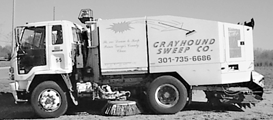
Only curbed roads will be swept because, Meehan says, "in open sections of road, debris is whipped off by wind and rain. It only collects in curbs and gutter lines."
Getting rid of that debris is good for the Bay as well as for the appearance of your neighborhood. County storm drains could back up if clogged from excess dirt. Once in the drain system, the debris enters our waterways.
On April 5, cleaning began in Edgewater. The machines will maneuver mostly north over the course of 90 days. Most of the county's nearly one thousand miles of curbed road are north of Route 214. But, according to project manager Charles Barnes, many roads in Southern Anne Arundel also meet the criteria. "I've got pages of southern communities," Barnes said. Galesville, Franklin Manor in Churchton and Boones Trailer Park in Lothian are on the list.
Doing the work is Grayhound Sweep Company of Upper Marlboro.
When the Greyhound sweeper comes to your neighborhood, signs will be posted 48 hours in advance. You'll want to move your vehicle from the path of the sweeping machine. Or you may awaken to find this vacuum is even stronger than you imagined.
-Mary Catherine Ball
In Pennsylvania, farmers in the Amish stronghold of Lancaster County are burning to grow a new product: hemp. No, it's not the intoxicating variety. It's a cousin whose fiber can be used to make paper products. The Philadelphia Inquirer reports that farmers may have a problem persuading the government to lift its ban, which could make it more difficult to detect illegal marijuana plants ...
In New Hampshire, legislators don't like the idea of wolves howling at the door. The U.S. Fish and Wildlife Service is looking at reintroducing the gray wolf, but their reputation for ferocity has some people and paper companies worried. Said State Rep. Larry Guay: "If they like wolves so much let them put them in Boston Common or Central Park" ...
Our Creature Feature this week is a doubler from the deep. In Boston, a group called Green World is leading the fight to save the barndoor skate. Members contend that this strange creature could become the first saltwater fish humans have driven to extinction in modern times. Often the big stingrays are killed by fishermen harvesting more valuable seafood. The National Marine Fisheries Commission says it needs more information to act.
Meanwhile, far to the south, the Patagonian toothfish is being fished within an inch of its life, the New York Times reported last weekend. And it takes a lot of inches, considering that the toothfish, also known as the Chilean sea bass, grows to six feet in length. The problem? They taste very, very good.
| Issue 15 |
Volume VII Number 15
April 15-21, 1999
New Bay Times
| Homepage |
| Back to Archives |